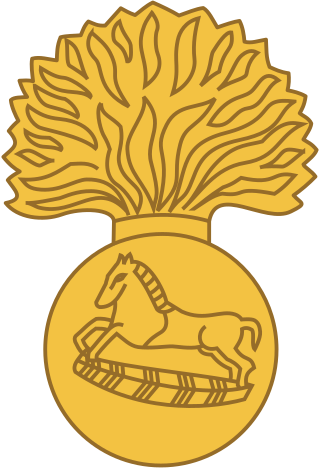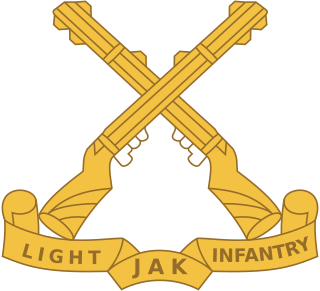
The 4th Indian Infantry Division, also known as the Red Eagle Division, is an infantry division of the Indian Army. This division of the British Indian Army was formed in Egypt in 1939 during the Second World War. During the Second World War, it took part in campaigns in East Africa, Syria, North Africa and Italy. Post independence, the division is part of the I Corps and headquartered at Prayagraj.

The Jat Regiment is an infantry regiment of the Indian Army, of which it is one of the longest-serving and most decorated regiments. The regiment has won 19 battle honours between 1839 and 1947, and post-independence it has won five battle honours, including 2 Victoria Cross, 8 Mahavir Chakra, 8 Kirti Chakra, 34 Shaurya Chakras, 39 Vir Chakras and 170 Sena Medals. During its 200-year service history, the regiment has participated in various actions and operations in India and abroad, including the First and the Second World Wars. Numerous battalions of the Jat Regiment, including the 14th Murray's Jat Lancers, fought in the First World War.

The Grenadiers is an infantry regiment of the Indian Army, formerly part of the Bombay Army and later the pre-independence British Indian Army, when the regiment was known as the 4th Bombay Grenadiers. It has distinguished itself during the two world wars and also since the Independence of India. The regiment has won many battle honours and gallantry awards, and is considered to be one of India's most decorated regiments with three Param Vir Chakra awardees in three different conflicts.

The Madras Regiment is the oldest infantry regiment of the Indian Army, originating in the 1750s. The regiment took part in numerous campaigns with the British Indian Army and the post-independence Indian Army.

The Jammu and Kashmir Light Infantry is an infantry regiment of the Indian Army. The regimental center is in Srinagar's Airport Complex at Awantipora with a winter setup near Jammu. Its regimental insignia consists of a pair of crossed rifles. The regiment mostly consists of volunteers from the state of Jammu & Kashmir and ethnic groups from the state. The Jammu and Kashmir Light Infantry is considered to be one of the most decorated regiment of the Indian army having won 1 Param Veer Chakra and 3 Ashok Chakra. Naib Subedar Chuni Lal of the 8th battalion Jammu and Kashmir Light Infantry is one of the most decorated personnel of the Indian Army.

Lieutenant General Sagat Singh, PVSM was a General Officer in the Indian Army notable for his participation in liberation of Goa and later in Indo-Pakistani war of 1971. He held many commands and staff appointments throughout his career.
The 15th Indian Division was an infantry division of the British Indian Army that saw active service in the First World War. It served in the Mesopotamian Campaign on the Euphrates Front throughout its existence. It did not serve in the Second World War, but was reformed at Dehradun in 1964 as part of the post-independence Indian Army.
20th Lancers is an armoured regiment in the Armoured Corps of the Indian Army. The regiment distinguished itself in operations with its defence of Chhamb in Jammu and Kashmir during the 1965 Indo-Pakistan War and won one Maha Vir Chakra. It has provided one Chief of Army Staff and two Army Commanders.
1841 Light Regiment is a regiment which is part of the Regiment of Artillery of the Indian Army.
861 Missile Regiment is a missile equipped regiment which is part of the Regiment of Artillery of the Indian Army.

193 Medium Regiment is part of the Regiment of Artillery of the Indian Army.
91 Field Regiment (Asal Uttar) is part of the Regiment of Artillery of the Indian Army.
195 Medium Regiment (Banwat) is part of the Regiment of Artillery of the Indian Army.
92 Field Regiment is part of the Regiment of Artillery of the Indian Army.
176 Medium Regiment is part of the Regiment of Artillery of the Indian Army.
1851 Light Regiment is part of the Regiment of Artillery of the Indian Army.
891 Field Regiment is part of the Regiment of Artillery of the Indian Army.
94 Field Regiment is part of the Regiment of Artillery of the Indian Army.
67 Field Regiment is part of the Regiment of Artillery of the Indian Army.
163 Medium Regiment is part of the Regiment of Artillery of the Indian Army.






